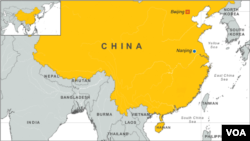China’s People's Liberation Army has expanded a navy base on the South China Sea, giving its fleet more clout in a strategic waterway disputed by five other countries and watched closely by Washington, security analysts say.
Over at least the past year, China’s navy expanded Yulin Naval Base on the island province of Hainan from a conventional submarine facility into a bay that berths nuclear submarines, military news database GlobalSecurity.org said. Four trestles for submarines, each 229 meters long, can accommodate 16 submarines, it says. Aircraft carriers and remote-sensing equipment are also expected to be based at or near Yulin, the site and other analysts say.
“It’s going to be kind of a future-oriented construction,” said Alexander Huang, strategic studies professor at Taiwan’s Tamkang University. “It takes time. It looks like they have all the hardware, all the construction ready, and it’s still going on.”
Expansion of the base increases Chinese access to the contested South China Sea, where its coast guard and navy already move through waters claimed by the other countries, analysts believe.
The base, on the north end of the sea, places ships near the tiny Chinese-held islets in the Paracel and Spratly archipelagos, where the navy can conduct exercises and monitor movements by other countries, analysts believe.
“That’s the hub, that’s the base of the south sea fleet, that’s what ultimately controls all the deployments in the Paracels and the Spratlys and it’s where most of the assets that you eventually see out there on the islands start out,” said Gregory Poling, director of the Asia Maritime Transparency Initiative at the Center for Strategic and International Studies in Washington.
China cannot easily station vessels permanently on the islets because of rough seas and distance from the Chinese mainland, he said.
Wider dispute
Beijing claims about 90% of the 3.5 million-square-kilometer South China Sea, a claim based on what it says are historic usage records. China has used technological and military superiority over the other claimants to develop and occupy some of the islets.
Brunei, Malaysia, the Philippines, Taiwan and Vietnam contest some or all of China’s claims to the sea that is coveted for fisheries, oil and gas.
Last year a Chinese coast guard vessel sank a Vietnamese fishing boat, and a Malaysian ship shadowed a Chinese coast guard vessel. Indonesia, while it does not claim any disputed islets, chased a Chinese coast guard vessel out of the southernmost part of the South China Sea. Indonesia and Vietnam filed notes to the United Nations on the incidents. China held military exercises in the sea in September and November.
Washington makes no claim but looks to Southeast Asia and Taiwan to help check Chinese military expansion around Asia. Growth of the Yulin base fits with a broader, 30-year Chinese naval modernization, Poling said.
China controls the 130 Paracel islands 340 kilometers southeast of Hainan province and spars there occasionally with Vietnam. One feature, Woody Island, has an airport, hangars and a civilian population of about 1,400. Three Spratly islets support Chinese airports and hangars.
The Yulin Naval Base would be the “jumping off point” for the more distant outposts, said Collin Koh, maritime security research fellow at Nanyang Technological University in Singapore.
“We have not yet seen a real permanent deployment, so that only means those forward bases and those further rearwards, such as those in Hainan, will increasingly become more important staging grounds,” Koh said.
Navy base improvements
The Yulin Navy Base, also home to a destroyer fleet, belongs to a wider southern naval command center established in 1951.
A base in Hainan province has been “massively improved” over the past year, the U.S. Naval Institute’s news website said in December, without naming Yulin specifically but calling the site connected to the South China Sea. It particularly noted efforts to “strengthen” an aircraft carrier base in the same province.
Yulin appears to be especially designed for future aircraft carriers, up to two per dock, Huang said. China’s first homegrown aircraft carrier, the Shandong, will serve the southern command region, “focusing on the South China Sea,” the Chinese state-supervised Global Times said in October. It entered the navy early last year.
The South China Sea off Yulin Navy Base averages a depth of 1,000 meters, ideal for submarine activity, GlobalSecurity.org says. Nuclear submarines can travel faster than conventional subs and surface less often.
Yulin further supports advanced sensing equipment to process information sent back from the contested sea, Poling said. It’s the “eyes and ears” for China’s holdings there, he said.









